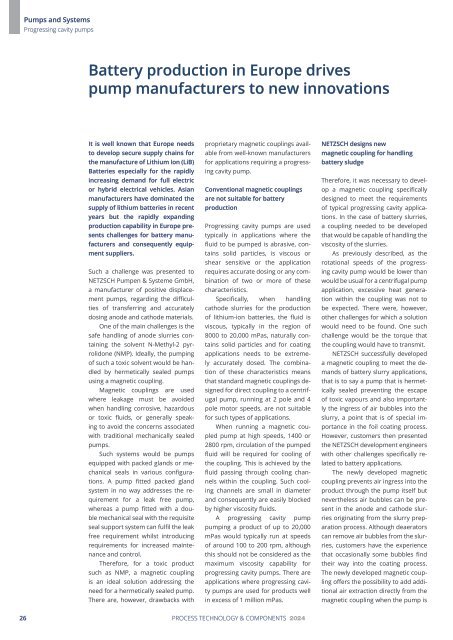PuK - Process Technology & Components 2024
A technical trade magazine with a history of more than 60 years.
A technical trade magazine with a history of more than 60 years.
You also want an ePaper? Increase the reach of your titles
YUMPU automatically turns print PDFs into web optimized ePapers that Google loves.
Pumps and Systems<br />
Progressing cavity pumps<br />
Battery production in Europe drives<br />
pump manufacturers to new innovations<br />
It is well known that Europe needs<br />
to develop secure supply chains for<br />
the manufacture of Lithium Ion (LiB)<br />
Batteries especially for the rapidly<br />
increasing demand for full electric<br />
or hybrid electrical vehicles. Asian<br />
manufacturers have dominated the<br />
supply of lithium batteries in recent<br />
years but the rapidly expanding<br />
production capability in Europe presents<br />
challenges for battery manufacturers<br />
and consequently equipment<br />
suppliers.<br />
Such a challenge was presented to<br />
NETZSCH Pumpen & Systeme GmbH,<br />
a manufacturer of positive displacement<br />
pumps, regarding the difficulties<br />
of transferring and accurately<br />
dosing anode and cathode materials.<br />
One of the main challenges is the<br />
safe handling of anode slurries containing<br />
the solvent N-Methyl-2 pyrrolidone<br />
(NMP). Ideally, the pumping<br />
of such a toxic solvent would be handled<br />
by hermetically sealed pumps<br />
using a magnetic coupling.<br />
Magnetic couplings are used<br />
where leakage must be avoided<br />
when handling corrosive, hazardous<br />
or toxic fluids, or generally speaking<br />
to avoid the concerns associated<br />
with traditional mechanically sealed<br />
pumps.<br />
Such systems would be pumps<br />
equipped with packed glands or mechanical<br />
seals in various configurations.<br />
A pump fitted packed gland<br />
system in no way addresses the requirement<br />
for a leak free pump,<br />
whereas a pump fitted with a double<br />
mechanical seal with the requisite<br />
seal support system can fulfil the leak<br />
free requirement whilst introducing<br />
requirements for increased maintenance<br />
and control.<br />
Therefore, for a toxic product<br />
such as NMP, a magnetic coupling<br />
is an ideal solution addressing the<br />
need for a hermetically sealed pump.<br />
There are, however, drawbacks with<br />
proprietary magnetic couplings available<br />
from well-known manufacturers<br />
for applications requiring a progressing<br />
cavity pump.<br />
Conventional magnetic couplings<br />
are not suitable for battery<br />
production<br />
Progressing cavity pumps are used<br />
typically in applications where the<br />
fluid to be pumped is abrasive, contains<br />
solid particles, is viscous or<br />
shear sensitive or the application<br />
requires accurate dosing or any combination<br />
of two or more of these<br />
characteristics.<br />
Specifically, when handling<br />
cathode slurries for the production<br />
of lithium-ion batteries, the fluid is<br />
viscous, typically in the region of<br />
8000 to 20,000 mPas, naturally contains<br />
solid particles and for coating<br />
applications needs to be extremely<br />
accurately dosed. The combination<br />
of these characteristics means<br />
that standard magnetic couplings designed<br />
for direct coupling to a centrifugal<br />
pump, running at 2 pole and 4<br />
pole motor speeds, are not suitable<br />
for such types of applications.<br />
When running a magnetic coupled<br />
pump at high speeds, 1400 or<br />
2800 rpm, circulation of the pumped<br />
fluid will be required for cooling of<br />
the coupling. This is achieved by the<br />
fluid passing through cooling channels<br />
within the coupling. Such cooling<br />
channels are small in diameter<br />
and consequently are easily blocked<br />
by higher viscosity fluids.<br />
A progressing cavity pump<br />
pumping a product of up to 20,000<br />
mPas would typically run at speeds<br />
of around 100 to 200 rpm, although<br />
this should not be considered as the<br />
maximum viscosity capability for<br />
progressing cavity pumps. There are<br />
applications where progressing cavity<br />
pumps are used for products well<br />
in excess of 1 million mPas.<br />
NETZSCH designs new<br />
magnetic coupling for handling<br />
battery sludge<br />
Therefore, it was necessary to develop<br />
a magnetic coupling specifically<br />
designed to meet the requirements<br />
of typical progressing cavity applications.<br />
In the case of battery slurries,<br />
a coupling needed to be developed<br />
that would be capable of handling the<br />
viscosity of the slurries.<br />
As previously described, as the<br />
rotational speeds of the progressing<br />
cavity pump would be lower than<br />
would be usual for a centrifugal pump<br />
application, excessive heat generation<br />
within the coupling was not to<br />
be expected. There were, however,<br />
other challenges for which a solution<br />
would need to be found. One such<br />
challenge would be the torque that<br />
the coupling would have to transmit.<br />
NETZSCH successfully developed<br />
a magnetic coupling to meet the demands<br />
of battery slurry applications,<br />
that is to say a pump that is hermetically<br />
sealed preventing the escape<br />
of toxic vapours and also importantly<br />
the ingress of air bubbles into the<br />
slurry, a point that is of special importance<br />
in the foil coating process.<br />
However, customers then presented<br />
the NETZSCH development engineers<br />
with other challenges specifically related<br />
to battery applications.<br />
The newly developed magnetic<br />
coupling prevents air ingress into the<br />
product through the pump itself but<br />
nevertheless air bubbles can be present<br />
in the anode and cathode slurries<br />
originating from the slurry preparation<br />
process. Although deaerators<br />
can remove air bubbles from the slurries,<br />
customers have the experience<br />
that occasionally some bubbles find<br />
their way into the coating process.<br />
The newly developed magnetic coupling<br />
offers the possibility to add additional<br />
air extraction directly from the<br />
magnetic coupling when the pump is<br />
26 PROCESS TECHNOLOGY & COMPONENTS <strong>2024</strong>

















